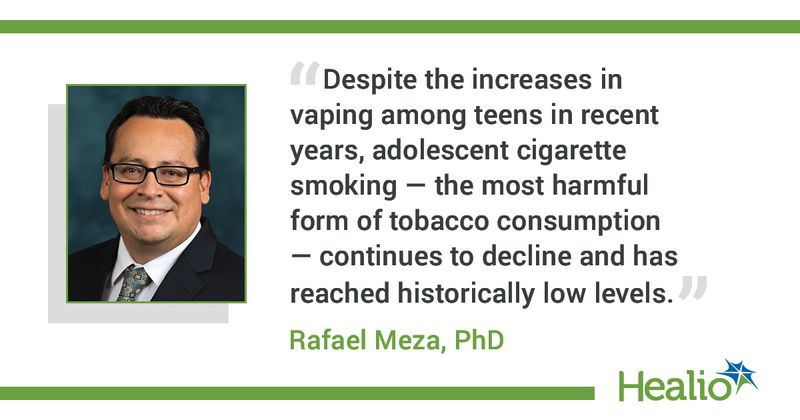Adolescent cigarette, smokeless tobacco use decreasing, despite rise in e-cigarette use
In a survey of adolescents from 2011 to 2019, cigarette and smokeless tobacco use has decreased rapidly since 2012 as use of e-cigarettes increased.
“Despite the increases in vaping among teens in recent years, adolescent cigarette smoking — the most harmful form of tobacco consumption — continues to decline and has reached historically low levels. This is also the case for other forms of tobacco use, such as smokeless tobacco and little cigar use,” Rafael Meza, PhD, associate professor and associate chair of the department of epidemiology and associate professor of global public health at the University of Michigan, Ann Arbor, told Healio. “This is great news and shows that education campaigns and tobacco control interventions are working to reduce youth and overall smoking. However, the increase in teen vaping is concerning and we should remain vigilant and continue efforts to prevent regular use of nicotine and tobacco products among youth.”

Researchers conducted a cross-sectional study to evaluate trends in adolescent tobacco product use. The study included 487,335 students in eighth grade, 447,310 in 10th grade and 424,236 in 12th grade. All completed the nationally representative Monitoring the Future survey from 1991 to June 2019.
From 1991 to 1997, the prevalence of daily smoking and use within the previous 30 days increased among all student groups, with continual and rapid reductions in recent years, according to the researchers.
Among 12th-grade males, daily smoking increased at an annual percentage change of 4.9% from 1991 to 1998, followed by decreases of –8% from 1998 to 2006, –1.6% from 2006 to 2012 and –17.4% from 2012 to 2019. Among 12th-grade females, daily smoking increased by 6.5% from 1991 to 1997, followed by decreases of –7.2% from 1997 to 2012 and –17.5% from 2012 to 2019.
Researchers observed similar results among younger adolescents. Daily smoking among eighth-grade males increased by 5% from 1991 to 1996, followed by decreases of –8.8% and –17.3% from 1996 to 2011 and 2011 to 2019. Among 10th-grade males, daily smoking increased by 7.1% from 1991 to 1997, followed by decreases of –11.1%, –0.7% and –17.9% from 1997 to 2005, 2006 to 2011 and 2011 to 2019, respectively. Among eighth grade females, daily smoking increased 10.9% from 1991 to 1996, followed by a decrease of –10.8% from 1996 to 2019 and among 10th grade females, daily smoking increased 7.2% from 1991 to 1997, followed by decreases of –9.5% and –16.3% from 2012 to 2019 and 1997 to 2012.
Until 2012, smokeless tobacco use was more variable, according to the researchers, with consistent decreases observed in the past 5 years. Smokeless tobacco use within the previous 30 days among 10th-grade males decreased by –6.5% from 1991 to 2004, with a 3.1% increase from 2004 to 2012, followed by a –11.6% decrease from 2012 to 2019. Results were similar among 12th-grade males, with decreases of –3.8% from 1992 to 2005, an increase of 3.1% from 2005 and 2015, followed by a decrease of –23% from 2015 to 2019.
Results were similar among Black and white adolescents.
The survey began asking adolescents about e-cigarette use in 2015. In 2015, e-cigarette use within the previous 30 days was 14.2% among 10th-grade students and 16.3% among 12th-grade students. Rates of use rose thereafter, with frequent e-cigarette use (> 20 days) reported by 20% of high school students in 2017, increasing to 34.2% in 2019. Researchers observed a similar increase in middle school students, with e-cigarette use reported by approximately 5% 2018.
“We need to better understand current patterns of tobacco use among adolescents and how vaping might affect their risk of smoking. We also need more research to figure out how to prevent kids from vaping, without increasing the risk that they would smoke instead,” Meza told Healio. “Finally, we need more research to understand how the emergence of new products, such as heat-not-burn tobacco, like IQOS, or oral nicotine products is going to affect current patterns of use among adolescents.”
Beyond research, Meza said “clinicians should continue advising [adolescents] not to smoke or use tobacco or nicotine, stress the harmful health consequences of tobacco use, particularly of cigarette smoking, and advise [adolescents] using e-cigarettes to get support to make sure they don’t get addicted to nicotine, and also to prevent them from switching to more harmful forms of tobacco use.”
For more information:
Rafael Meza, PhD, can be reached at meza@umich.edu.
